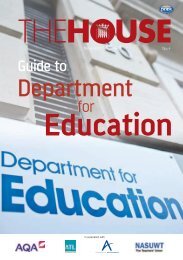Oracy
2fcBkno
2fcBkno
Create successful ePaper yourself
Turn your PDF publications into a flip-book with our unique Google optimized e-Paper software.
Using Makaton sign language to develop spoken language skills<br />
Staff at Green Lane Primary School believe oracy plays a<br />
critical role in their pupils’ language development, and that a<br />
large part of their role is to help pupils improve their spoken<br />
communication. The school works with a high proportion of<br />
pupils for whom English is an additional language, and these<br />
pupils often have limited development in their first language<br />
when they arrive in nursery.<br />
“When they come to school, we’re throwing them into a language that<br />
is new to them really, so for those children we feel it’s really important<br />
we help them catch up as quickly as possible, and immerse them in<br />
the language. …But that is the majority of our children”<br />
Lorraine Lee, Pupil Progress Leader<br />
All the teaching staff at the school use Makaton sign language with their classes alongside spoken<br />
English. Teachers say this gives pupils confidence as verbal communicators because it helps<br />
them think through and formulate their speech. Staff attend weekly training sessions in Makaton<br />
signing with the manager of the school’s Designated Special Provision, Angela Catterick. Senior<br />
leaders and class teachers believe Makaton is used consistently throughout the school and that it<br />
underpins pupils’ academic progress. One of the school’s nursery teachers explains it can initially be<br />
intimidating to learn, but “seeing it in practice and seeing it work” in her colleagues’ lessons has<br />
given her greater incentive to embed it in her own.<br />
“It starts with having your basic needs met. Particularly<br />
for our nursery children, we’ve found that since we’ve<br />
started using Makaton a lot more that the communication<br />
comes along a lot faster. That then builds to being able to<br />
argue, being able to make your opinion known, being able<br />
to access information”<br />
Jane Townend, Deputy Headteacher<br />
Other classroom strategies used across the school include:<br />
• ‘Target’ vocabulary in each class, each week, which class teachers then return to and embed<br />
throughout the year<br />
• Modelling of both spoken English for the purposes of general communication, and also subjectspecific<br />
language. Teachers speak in full sentences, and encourage pupils to do the same<br />
• Scaffolding communication through, for example, Makaton, sentence starters, setting ‘rules’<br />
for talk, and practising active listening in lessons<br />
Angela says pupils’ development in spoken language is frontloaded, with pupils making most<br />
progress between the nursery and year 3. After that “we’re looking at much finer tuning, and<br />
developing at a more advanced level.”<br />
27




